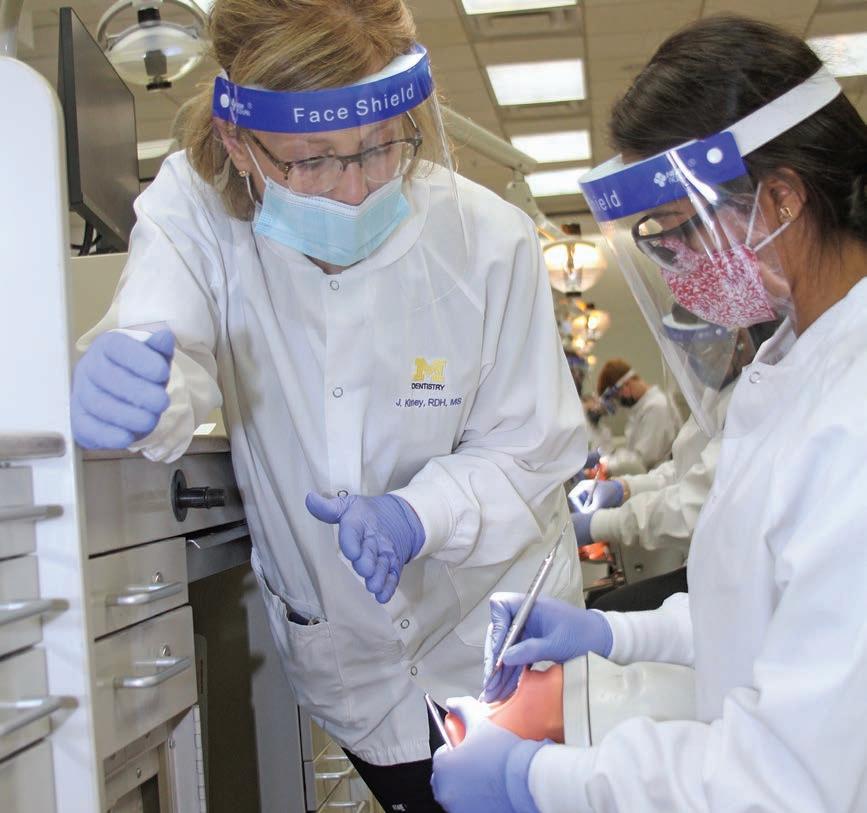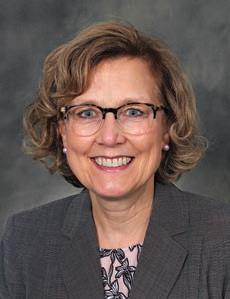
6 minute read
FACULTY Profile: Janet Kinney
by M Dentistry
Patience and persistence led a DH alumna back to the dental school and a leadership position
As the Dental Hygiene program at the University of Michigan School of Dentistry prepares to celebrate its centennial in 2021, its director, Janet Kinney, is leading it through changes that will be major milestones in its history. The COVID-19 pandemic brought a set of challenges that required the program to implement creative and groundbreaking solutions when a portion of the traditional in-person classes and hygiene training were forced to move online. That layer of complexity hit just as the program was already in the midst of a significant changeover for its undergraduate BSDH degree, moving it from the longstanding three-year course of study with summer breaks to a year-round schedule that requires only two years to complete. With the upcoming centennial bringing a focus on history, Kinney said she is at once grateful and inspired to be part of both a program and dental school with such longstanding records of excellence and leadership in dentistry. “Being here at Michigan, being in this environment, with excellence in multiple areas – education, research and service – it’s very rewarding,” she said. “In this job, there is never a dull moment and always something happening. But we have such great collaboration and great resources so that we can excel in all those areas." Kinney’s path to this leadership position in academia seemed unlikely in the early years of her career. After receiving her BSDH from the U-M dental school in 1983, she started a 20-year trek through clinical practice in the United States and Europe, moving every three years on average as her husband, Steve, was promoted and transferred for his engineering and finance positions in the automotive industry. Kinney practiced briefly in Lansing after earning her degree, then they moved to the Detroit, Minneapolis and Toledo areas, followed by time in Zurich, Switzerland, then to London, England, and back to Zurich.

“I’m proof that this profession has flexibility,” Kinney says. “I was very fortunate because my career could pick up and move. It was good exposure for me.” She learned that dental problems and treatment are pretty much universal – even when the patient in the dental chair is speaking German. In London, she couldn’t practice as a hygienist because the United Kingdom didn’t recognize U.S. licenses at the time. Even that had a benefit, Kinney said, because she worked instead as a dental assistant and learned firsthand the demands and challenges of another position in the dental office. “When I graduated in 1983, I had it in my mind to come back to school for my master’s after probably about five or six years of practicing,” she said. It ended up being 21, but her patience and persistence paid off in 2004 when she applied for graduate school and was offered a graduate fellowship. As Kinney worked on her master’s degree, she was returning to interests she had developed many years before. She originally started college with the intent of majoring in education and becoming a teacher, but that changed when she took a job as a receptionist in the East Lansing dental office of the late Dr. George Bettman (U-M DDS 1952). She spent a lot of time watching how patients received treatment from the dentist and his hygienists. “I saw how dental hygiene can impact someone’s life in such a positive way,” she said. “Lots of Michigan State students were patients there, including some with serious dental issues. I saw first-hand how the hygienists could transform someone who came in with severe periodontal disease and bring them back to good oral health. I decided I wanted to do that.” Continued
Those early interests in teaching and periodontics merged nicely as she worked on her master’s degree. And then she was surprised by a new interest that led to a second master’s degree. She credits periodontics faculty members at the time, Drs. William Giannobile and Laurie McCauley, with introducing her to the joys of clinical research. “When I came back as a graduate student, I loved clinical practice because that was all I had done for 20 years,” Kinney said. “I knew clinical research drove clinical practice, but I didn’t understand how I, as a hygienist, could participate in clinical research and drive those clinical protocols. So it was this ‘aha’ moment, this epiphany, for me that I have all these skills that I can use in research. I still have patient interaction, but I like the analytical parts of it. I like generating data and seeing what those results are and how those translate to patient care. That’s an exciting, fulfilling part for me when I have those opportunities.” That newfound interest translated to a master’s degree in Clinical Research Design and Statistical Analysis from the Department of Biostatistics and Epidemiology at the U-M School of Public Health to go with her master’s in Dental Hygiene, both conferred in 2007. Much of the research on her extensive list of funded research and peer-reviewed publications involves salivary diagnostics as predictors of periodontal disease progression. After finishing her graduate degrees, Kinney joined the Dental Hygiene division as an adjunct clinical lecturer for a year, then was hired as a clinical assistant professor. In 2012, she was named Director of Dental Hygiene. She was promoted to associate professor in 2015 and this year became a full professor, all within the Department of Periodontics and Oral Medicine, home to the Dental Hygiene division. Her job description as director is a busy, hands-on combination of administering the division, teaching and research. She teaches both entry-level and graduate-level courses, while sitting on thesis committees and providing academic and career mentoring for students. Administratively, the biggest initiative of the last several years has been the conversion to a two-year, year-round BSDH program. The three-year transition took Kinney and the Curriculum Committee countless hours of revising the schedule of teaching and clinic times while students in the former format finished even as new students entered under the new format.
“I think what we are seeing early on is that it is a good move, based on the profile of our students coming into the program,” Kinney said. “We felt our hygiene students needed to have more involvement, activities, interaction and patient care with dental students. And for their clinical skill-building, they now will have instruments in their hands for two straight years with no breaks between spring and summer where they potentially lose some of their hand skills. And students today like that they can finish in two years and get on with their careers or graduate school.” Dealing with the COVID-19 pandemic brought a wave of administrative and teaching challenges, but also yielded a set of creative technological innovations that allowed hygiene students to mix in-person training with online video interactions with faculty. (See related story in this magazine’s Dental Hygiene section.) “It’s thinking way outside of the box for us,” Kinney said. “It’s using technology and pushing all of our technology skills. I think students have embraced it. We want to make sure our first-year students are ready to see patients next semester. It looks like we are going to meet that goal.” The creativity and collaboration required by the pandemic illustrate what has always been a strength of the Dental Hygiene Division, Kinney said. “We have had to be very creative with curriculum design. I point to our Curriculum Committee because I like to say it takes a village. I couldn’t do this if I didn’t have those people who come in and give 110 percent every day, not just 9 to 5. This is not Janet Kinney running the show. That is not the way this program has ever worked, but especially now. We have really had to put our heads together,” she said. “It’s kind of awesome to sometimes stop and think about working with so many people dedicated to excellence at the dental school. I work with some phenomenal people who just give their all every single day.”




